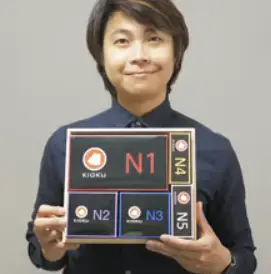KIOKU Japanese Flashcards Combine Memory Science with Japanese Craft
- Sarah H.

- Jul 15
- 3 min read
Updated: Aug 20
We sat down for an express interview with Rem from the KIOKU team, whose cleverly crafted Japanese learning flashcards are winning over students worldwide. What started with scissors and index cards evolved into a complete JLPT-ready system powered by memory science and enhanced by traditional Kiribako packaging. In just a few short answers, Rem gives us insight into the philosophy and practicality behind KIOKU—and where it’s headed next.

From handmade cards to polished tool
Your journey to JLPT N1 started with handmade flashcards. How did that personal learning experience shape the final design of the KIOKU system?
My JLPT N1 journey started with scissors and index cards. Five‑minute pocket sessions on a bus beat hours of desk study, yet friends wouldn’t copy the idea because making cards took longer than using them. A small handmade batch at my university festival proved the solution: ready‑to‑use cards turn intent into action. KIOKU keeps that promise in a polished, pocket‑size form.
Physical flashcards still matter in a digital age
KIOKU blends the simplicity of paper flashcards with sophisticated learning science like the forgetting curve and spaced repetition. Why do you think this physical approach still resonates in our app-dominated world?
A phone buzzes; a card doesn’t. The tactile flip creates a micro‑ritual that locks attention and leverages spaced repetition. Multiple studies (HES‑SO Valais, Kyushu U) show higher retention with paper over screens. We plan a companion app for listening, but paper remains the fastest path to full focus for a two‑minute window.
How to make KIOKU full-featured yet compact and user-friendly
The project now covers Kanji, Vocabulary, and Grammar—what was the biggest challenge in expanding to a full-language system, and how did you ensure it stayed user-friendly and portable?
Density. We wanted the portability of a child’s flashcard yet the breadth of a 500‑page textbook. Anything that didn’t trigger recall in three seconds—stroke‑order diagrams, long translations—was cut.
One card, one memory cue kept the deck slim and study sessions feel doable.
Kiribako wooden boxes for packaging
You’ve partnered with traditional Kiribako craftsmen for packaging. What inspired this fusion of ancient Japanese craft with modern language learning tools?
Centuries‑old manuscripts in Japanese museums sit in paulownia (kiribako) boxes, not steel safes, because the wood breathes, repels insects, and cushions shock.
Partnering with Mr. Tobari’s 150‑year‑old workshop felt like preserving knowledge instead of scrolls—a handshake between past and present.
What’s next for KIOKU?
Looking ahead, you mentioned multilingual and specialty decks. What kinds of learners or use cases do you envision next for the KIOKU ecosystem?
In‑house printing lets us run 30 decks instead of 30 000, so translations (Spanish, German, French, Portuguese, etc.) become practical.Micro‑runs also unlock niche sets—tea‑ceremony phrases, aikido commands, engineering kanji—and even subjects beyond Japanese, like chemistry symbols or math formulas.
Anywhere long‑term memory is the bottleneck, KIOKU can drop in.
Even in an app-filled world, KIOKU proves that a simple flashcard, thoughtfully designed and beautifully made, can still hold a powerful edge in language learning. From deep study sessions to quick two-minute bursts, it’s a tool shaped by experience and made to fit your life. With more decks and subjects on the horizon, this is only the beginning for the KIOKU ecosystem.
KIOKU: Complete Japanese Learning card Series
About RB Inc. team

Rem is part of the RB Inc. team in Japan, where innovation meets everyday utility. With a focus on smart, fun, and efficient solutions, Rem and the team aim to make life a little smoother—one clever product at a time. KIOKU is their latest offering, born from hands-on experience and a passion for practical learning tools.



















.png)











